The mines of Potosí
12 December 2005
10:11 AM
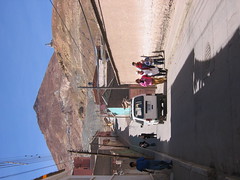
At 5:00am today we got back from our trip to Sucre and Potosí, two Bolivian cities south of Cochabamba. I’m going to split the trip into a few smaller stories over the following days. This first portion is a little longer than usual, so here’s a sneak peek at the highlights: silver, dynamite, toxic chemicals, and the black lung.
Roy, Emily, Caitlin, and I left Cochabamba Thursday night at 8:30pm, bound for Potosí. About 20 minutes into the drive, I was excited when the new Harry Potter movie started playing on the bus TV (courtesy of a pirated DVD, of course). We made a short stop in Oruro at 2:30am. By 5:30am we had arrived in Potosí. We hopped a cab to a hostel near the town center and crashed until breakfast time.
Potosí is a city of superlatives. It is the highest city in the world, at an altitude of 13,400 ft. Centuries ago, it was the wealthiest city in all of South America. Spanish conquistadors came to Potosí in 1544 and found the local mountain, Cerro Rico, to be extremely rich in silver. By one estimate, over 55,000 tons of silver were mined from the mountains of Potosí alone.
Silver and mining are a significant part of Potosí’s history so we decided to take a tour of the mines. We showed up at 8:00am Friday morning. In short order our guides outfitted us with rubber boots, pants and jackets to cover our clothes, and hardhats with headlamps. We looked ready for adventure.
The first stop on the tour was the miners’ market. There you can buy anything remotely related to mining: headlamps, fuel, tools, fuses, alcohol, drinks, and dynamite. Anyone can buy dynamite—there aren’t any laws prohibiting its sale. In fact, our guide recommended that we buy some so we could see an explosion. So we got a stick of dynamite, a fuse, and a sack of ammonia nitrate to make the explosion “two to three times as big,” all for $2.15.
At the miner’s market we also had to buy gifts for the men in the mines. We bought a bottle of rubbing alcohol, which the miners drink often. It’s inexpensive and 96% alcohol (and not denatured like in the U.S., so it won’t kill you—at least not immediately). We also bought a few bags of coca leaves. The coca leaf is known in the U.S. as the base ingredient in cocaine, but it is used much here in herbal teas and for chewing. Miners chew coca twice or three times a day in lieu of eating and to energize themselves. Our guide told us that coca is such an integral part of mining here that roughly 12% of each miner’s salary goes towards buying coca.
Our second stop was one of the 27 refineries in Potosí. There are 98 different minerals in Potosí’s Cerro Rica (“rich hill”), but for economic reasons, only four are extracted today: silver, zinc, tin, and lead. In the refinery we saw machines that crush the ore and the toxic chemical processes used to extract minerals from their ores. Afterwards the minerals float in a chemical foam where rotating blades skim the foam into washing chambers. Our guide washed some foam and showed us the silver dust. This semi-refined product is shipped elsewhere for further processing. The current market price for silver is about $8 per troy ounce.
The last stop was far and away the most interesting. We entered the mine and sloshed through the mud and dirt. Roy (6’2”) and I (6’0”) lamented that the mines were built by and for Bolivians (short). We slouched, crouched, and crawled through the mine. After entering on the first level we descended to the second. There we met a group of ten workers.
The most polite way I can think to describe the work there is this: it is hell. In the mines it is dark, cramped, hot, hard to breathe, and dangerous. Once the government owned the mines, but now the workers themselves own them. They work in groups and make their own hours. As with any form of self-employment, this is a mixed blessing. Sometimes they work five days a week, sometimes seven; sometimes they work just 12 hours a day, sometimes 18, sometimes 24. They do have health insurance and they can retire and receive a pension when they have lost 50% of their lung capacity.
When we met this first group of workers they were taking turns drilling holes to load with dynamite. To have an effective explosion, they drill ten to twelve holes and load each with a half-stick of dynamite and ammonia nitrate. While three attended to the drilling, the others rested. We gave the workers our gift of coca leaves and alcohol. They thanked us heartily and invited us to have a drink of their rubbing alcohol cocktail. Refusing food or drink in Bolivia is a grave offense, so we took the smallest sips possible from a cough-syrup-sized cup.
When we left the 10-worker group, we went down to the fourth level by way of a series of tenuous ladders. We saw a variety of dark, bottomless pits and we were careful not to allow our bodies to accidentally find the bottoms. Finally we met up with a solo worker. He worked without machinery, using techniques unchanged from centuries earlier. This man was 30 years old; he had worked in the mines for 16 of those 30. He is married, has five children, and sometimes works 24-hour days. Thanks to self-employment, these workers earn in proportion to how much they work, and also the quality and quantity of their ore. The average monthly wage is 1,000 bolivianos ($125), though it can fluctuate from 400 Bs. in a bad month ($50) to 3,000 Bs. during a good one ($375). For the ten minutes we talked with this miner, we were pretty uncomfortable, and it had nothing to do with the numbers. It was hard to breathe and it was about 95F. Sometimes temperatures inside the mountain reach 115F.
Thankfully, we made our way out of the mine rapidly. After two-and-a-half hours in the darkness, we were elated to see the light of day again. I don’t think I can adequately convey how dirty we were after leaving the mine except with pictures. Here is Roy, before and after the mine:
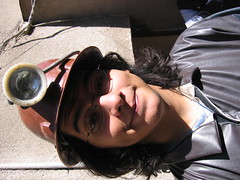
Before |
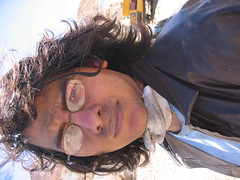
After |
In Roy’s defense, we were all pretty dirty.

|

|

|
We had the good sense to buy masks to protect against the dust in the mines. They were surgical white when we entered. When we left they looked…well, like this:
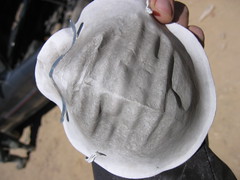
This mask represents 150 minutes in the mines. You can only imagine what your lungs might look like after 15 or 20 years.
Last but not least, the dynamite. We did with it what you do with dynamite: we blew it up.
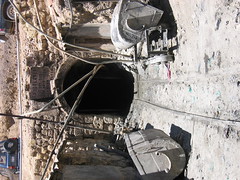
Comments